| Costa Rica Corcovado: In search of the Two Toed Sloth |
| Sometimes I think I have the best job in the world. From the amazing grassy plains of Venezuela, I traveled to Corcovado National Park, Costa Rica. Not only is this lush rainforest here amazingly beautiful, but I also got to swing on vines |
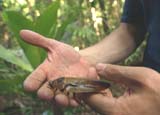 |
The rainforest is home to an huge array of animals. One I found quickly is the giant cockroach. This Insect was so big it would never fit into a roach motel. |
| You know, roaches have been around since the dinosaurs and they’ll probably be here long after were gone. Like all insects, the giant cockroach wears its skeleton outside its body. How does it grow? As the cockroach gets larger, the exoskeleton splits open like a zipper.
And what am I looking for in Corcovado National park? Our Feature Creature is the reclusive, slow-moving two-toed sloth. But since the Costa Rican rainforest is home to hundreds of thousands of plants and animals, I wanted to enjoy my hunt, stopping to see as much as I could.
|
| The rainforest is incredibly lush, with lots of streams that drain the rains. Its also rich in mineral deposits. Columbus even got gifts of gold figurines form the natives. One little statue of a frog is modeled on one of the first animals I spot, the poison dart frog. |
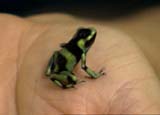 |
| Why is it called the poison dart frog? The little frog contains a poison that the natives would use on their arrowheads and spears. There’s a variety of these poison frogs. Some produce a toxin that might only give you a upset stomach, while another has venom powerful enough to kill a thousand people. Predators avoid the frog for good reason. Behind the Scenes:You’d think that after all my warnings about the poison dart frog, I would have been careful. But just after handling the frog, I rubbed my eyes. And sure enough, within minutes my eyes started tearing as they got all puffed up from the little frog’s venom. But I’m all better now. Not long into my trek into the rainforest, I was greeted by the noise of the howler monkeys. These monkeys eat leaves and use their prehensile tails to hang from branches. |
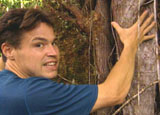 |
Not all the action involves the animals. I see a lot of trees with strangler vines wrapped around them. These vines are doing just that... strangling the tree as they wrap around it. |
| Many of the birds of the rainforest are brilliantly colorful. I spotted a scarlet macaw, which uses its beak to climb trees. These beautiful birds are facing extinction because so many have been captured for pets. Coming to a river, I stopped and panned for gold. Hey, you never know! |
| Then I saw one of the rulers of the rainforest, the jaguar. This is the largest cat in the New World, and its name means “to kill and pounce” -- which, believe me, it does. Its padded paws allow it to creep up quietly... but the jaguar is also endangered because of its beautiful fur. |
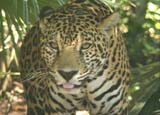 |
| I’d miss a lot of the wildlife in the rainforest if I didn’t look up. Up in the canopy, the roof of the forest, I spotted a leaf-mimic katydid, an animal that looks like a leaf, complete with leaf mold and holes. The canopy is also home to the green vine snake, an arboreal snake who also looks a lot like the surrounding vegetation. Though we were in search of one of the slowest animals, I saw one of the fastest, the basilisk, also known as the Jesus Christ lizard. Why is it called that? Because this lizard moves so fast it can run on water. |
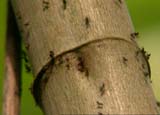 |
I knew I was near sloth country when I spotted a cecropia tree. These trees have an interesting relationship with Aztec, or army ants. The ants bore hundreds of tunnels in the trunk of the tree. In exchange for a home, these army ants attack any creature that tries to eat the trees leaves. This two-way relationship is called mutualistic symbiosis. |
| Behind the Scenes:When we were looking for the sloth we jostled a palm tree a bit, not knowing that something other than a sloth lived there. But in a few minutes we started getting stung! We had disturbed a killer bee nest, and the bees were everywhere -- in our ears, noses, under our shirts. Everyone was running around and getting stung, but believe it or not, it was actually funny! The stingers hurt, but they weren’t deadly. Some of the animals are even above the canopy. I spotted a soaring harpy eagle. That predatory bird cruises the canopy for monkeys and arboreal bats. Now I started to get a bit concerned. Here I was in a place where I should see the sloth, but no luck so far. I did see a giant red-winged grasshopper. This big insect jumps 15 feet and has an interesting defense mechanism. It eats poisonous leaves, storing them. If it is eaten, the creature that ate it dies... so the grasshopper sacrifices itself for the rest of its species. |
| Finally, I spotted a big fur mound, and yes, I know I've found our elusive Feature Creature, the two-toed sloth. Close up, I can see easily why it got its name. |
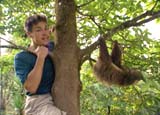 |
| While it has three big toes in the back, it has only two in the front. These toes are actually claws, very useful for slashing in defense. The sloth has a special way of taking care of its young. The baby lives in its mother’s fur, feeding off the algae that grows there for about seven months, until it is ready to begin its slow-moving life in the Corcovado Rain Forest. Behind the Scenes:The baby sloth bit down on my hand -- slowly --and I had to wait until it opened its mouth to slowly extract its sharp teeth. This time I was bitten on the pinkie. Ouch! I sure go through a lot of Band-Aids! What a place the Costa Rican Rainforest is, and there’s so much more to see. But I’m heading north now, for my next adventure with wild life in Los Angeles, California. Hope you join me for a howling good time!Totally Wild,
Jeff
|
|

